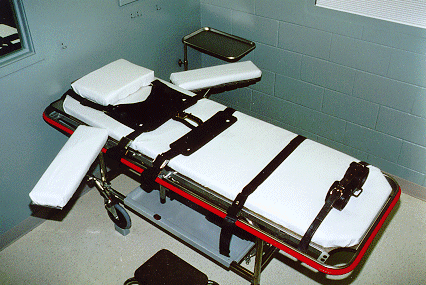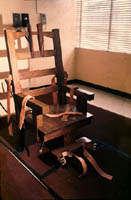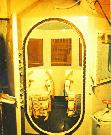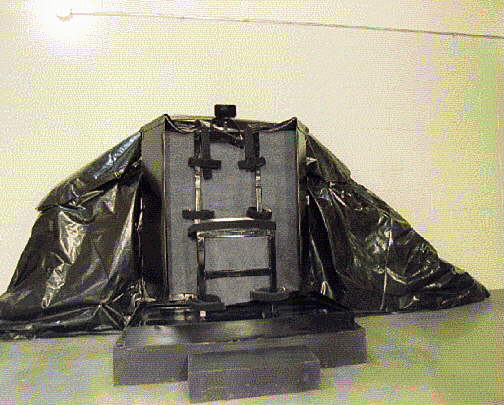
In Indiana prior to 1913, all executions were by hanging. From 1913 through 1994, all executions were
by electric chair. Since 1995, all executions have been by lethal injection. Current execution
procedure is found at
Indiana Code 35-38-6 and
requires that the lethal injection execution take place inside the walls of the Indiana State Prison at Michigan City before sunrise.
Indiana Code 35-38-6-1 Execution Procedure
(a) The punishment of death shall be inflicted by intravenous injection of a lethal substance
or substances into the convicted person:
(1) in a quantity sufficient to cause the death of the convicted person; and
(2) until the convicted person is dead.
(b) The death penalty shall be inflicted before the hour of sunrise on a date fixed by the sentencing court.
However, the execution must not occur until at least one hundred (100) days after the conviction.
(c) The superintendent of the state prison, or persons designated by the superintendent,
shall designate the person who is to serve as the executioner.
(d) The department of correction may adopt rules under IC 4-22-2 necessary to
implement subsection(a). [As added by P.L.311-1983, § 3. Amended by P.L.294-1995, § 1; P.L.20-2002, § 1; P.L.67-2017, § 15;
P.L.217-2017, § 158, effective April 27, 2017; P.L.86-2018, § 334, effective March 15, 2018.]
As of December 31, 2020, a total of 31 states and the federal government authorized the death penalty.
Methods of execution are defined by statute and vary
by jurisdiction. In 2020, all 31 states with a death
penalty statute authorized lethal injection as the primary method
of execution. However, fifteen states also authorized
alternative methods of execution: electrocution
(9 states), lethal gas (3), firing squad (3), nitrogen
hypoxia (3), and hanging (2). In states that authorized
multiple methods of execution, the condemned
prisoner may select the method. Five states
(Arizona, Arkansas, Kentucky, Tennessee, and Utah)
stipulate which method must be used depending on
the date of either the crime or the sentencing. Six states
authorized alternative methods if lethal injection was
ruled to be unconstitutional: Arkansas authorized
electrocution; Delaware authorized hanging;
Mississippi and Oklahoma authorized electrocution,
firing squad, or nitrogen hypoxia; Utah authorized
firing squad; and Wyoming authorized lethal gas.
Federal prisoners are executed by lethal injection,
pursuant to 28 C.F.R. Part 26. For offenses prosecuted
under the federal Violent Crime Control and Law
Enforcement Act of 1994, the law of the state in which
the conviction took place determines the method used
(18 U.S.C. § 3596).
Recent State Action:
In 2020, the Colorado legislature repealed the death penalty for first-degree murder charged on or afer July
1, 2020 (SB 20-100). The law became effective on March 23, 2020, and specifed that the repeal
was prospective and did not afect the sentences of the three male prisoners under previously imposed death
sentences. However, the death sentences for the three prisoners were commuted to life without the possibility
of parole by the governor on the same date the repeal bill was enacted.
In 2019, New Hampshire repealed its death penalty statutes (HB 455), efective May 30, 2019. The repeal did not
affect previously imposed death sentences, and as of December 31, 2020, New Hampshire held one male
prisoner under sentence of death.
In 2018, the Washington Supreme Court declared the state death penalty statute unconstitutional as applied,
State v. Gregory, 192 Wash. 2d 1, 427 P.3d 621 (2018). The Washinton state legislature has neither
revised nor repealed the statute.
The Delaware Supreme Court held that a portion of Delaware’s death penalty sentencing statute
(11 Del. C. § 4209) was unconstitutional (Rauf v. State, 145 A.3d 430 (Del. 2016)). No legislative
action has been taken to amend the statute. As a result, capital cases are no longer pursued in Delaware.
The New York Court of Appeals held that a portion of New York’s death penalty sentencing statute
(C.P.L. 400.27) was unconstitutional. People v. Taylor, 9 N.Y.3d 129 (2007). No legislative action
has been taken to amend the statute. As a result, capital cases are no longer pursued in New York.
STATE STATUTES / METHOD OF EXECUTION
| Jurisdiction |
Statute |
Primary Method |
|
Alabama
|
15-18-82(a)
|
Lethal Injection or
Electrocution
|
|
Arizona
|
13-704
|
Lethal Injection or Gas
|
|
Arkansas
|
5-4-617(a)(1)
|
Lethal Injection or Electrocution
|
|
California
|
Penal Code Sec. 3604
|
Lethal Injection or Gas
|
|
Colorado
|
18-1.3-1202
|
Lethal Injection
|
|
Connecticut
|
54-100
|
Lethal Injection
|
|
Delaware
|
Title 11, S. 4209
|
Lethal Injection or Hanging
|
|
Florida
|
922.105
|
Lethal Injection or
Electrocution
|
|
Georgia
|
17-10-38
|
Lethal Injection
|
|
Idaho
|
19-2716
|
Lethal Injection
|
|
Indiana
|
35-38-6-1
|
Lethal Injection
|
|
Kansas
|
22-4001
|
Lethal Injection
|
|
Kentucky
|
431.220
|
Lethal Injection
|
|
Louisiana
|
15:569
|
Lethal Injection
|
|
Maryland
|
3-905
|
Lethal Injection
|
|
Mississippi
|
99-19-51
|
Lethal Injection
|
|
Missouri
|
546.720
|
Lethal Injection or Gas
|
|
Montana
|
49-19-103(3)
|
Lethal Injection
|
|
Nebraska
|
29-2543
|
Electrocution
|
|
Nevada
|
176.355
|
Lethal Injection
|
|
New Hampshire
|
630:5 (XIII)
|
Lethal Injection
|
|
New Mexico
|
31-14-11
|
Lethal Injection
|
|
New York
|
C. 43 - Art.22-B,658
|
Lethal Injection
|
|
North Carolina
|
15-187
|
Lethal Injection
|
|
Ohio
|
2949.22
|
Electrocution or
Lethal Injection
|
|
Oklahoma
|
22-1014
|
Lethal Injection or Electrocution or
Firing Squad
|
|
Oregon
|
137.473
|
Lethal Injection
|
|
Pennsylvania
|
Title 61, Sec. 3004
|
Lethal Injection
|
|
South Carolina
|
24-3-530
|
Lethal Injection or
Electrocution
|
|
South Dakota
|
23A-27A-32
|
Lethal Injection
|
|
Tennessee
|
40-23-114
|
Lethal Injection or Electrocution
|
|
Texas
|
TCCP, Art. 43.14
|
Lethal Injection
|
|
Utah
|
77-18-5.5
|
Lethal Injection or
Firing Squad
|
|
Virginia
|
53.1-233
|
Lethal Injection or
Electrocution
|
|
Washington
|
10.95.180
|
Lethal Injection or Hanging
|
|
Wyoming
|
7-13-904
|
Lethal Injection or Gas
|
|
Federal Govt
|
28 CFR 26.3
18 USC 3596
|
Lethal Injection or
State Method
|
LETHAL INJECTION
 Procedure: State statutes typically provide: "The punishment of death must be inflicted by continuous, intravenous administration of a lethal quantity of an ultrashort-acting barbiturate in combination with a chemical paralytic agent until death is pronounced by a licensed physician according to accepted standards of medical practice."
Procedure: State statutes typically provide: "The punishment of death must be inflicted by continuous, intravenous administration of a lethal quantity of an ultrashort-acting barbiturate in combination with a chemical paralytic agent until death is pronounced by a licensed physician according to accepted standards of medical practice."
The execution protocol for most jurisdictions authorizes the use of a combination of three drugs. The first, sodium thiopental or sodium pentothal, is a barbiturate that renders the prisoner unconscious. The second, pancuronium bromide, is a muscle relaxant that paralyzes the diaphragm and lungs. The third, potassium chloride, causes cardiac arrest. Each chemical is lethal in the amounts administered.
The inmate is escorted into the execution chamber and is strapped onto a gurney with ankle and wrist restraints. The inmate is connected to a cardiac monitor which is connected to a printer outside the execution chamber. An IV is started in two usable veins, one in each arm, and a flow of normal saline solution is administered at a slow rate. One line is held in reserve in case of a blockage or malfunction in the other. At the warden’s signal, 5.0 grams of sodium pentothal (in 20 cc of diluent) is administered, then the line is flushed with sterile normal saline solution. This is followed by 50 cc of pancuronium bromide, a saline flush, and finally, 50 cc of potassium chloride. (See California Execution Procedures).
The most common problem encountered is collapsing veins and the inability to properly insert the IV. Some states allow for a Thorazine or sedative injection to facilitate IV insertion.
History: Lethal injection had first been proposed as a means of execution in 1888 when New York considered it, but ultimately opted for electrocution. In 1977, Oklahoma became the first state to adopt lethal injection. Texas performed the first execution by lethal injection in 1982 with the execution of Charlie Brooks.
Current Application: 20 states authorize lethal injection as the sole method of execution. 16 other states provide for lethal injection as the primary method of execution, but provide alternative methods depending upon the choice of the inmate, the date of the execution or sentence, or the possibility of the method being held unconstitutional. Since 2008, almost 90% of all U.S. executions have been by lethal injection.
ELECTROCUTION
 Procedure: State statutes typically provide: "The sentence shall be executed by causing to pass through the body of the convict a current of electricity of sufficient intensity to cause death, and the application and continuance of such current through the body of such convict shall continue until such convict is dead." Procedure: State statutes typically provide: "The sentence shall be executed by causing to pass through the body of the convict a current of electricity of sufficient intensity to cause death, and the application and continuance of such current through the body of such convict shall continue until such convict is dead."
The execution protocol for most jurisdictions authorizes the use of a wooden chair with restraints and connections to an electric current. The offender enters the execution chamber and is placed in the electric chair. The chair is constructed of oak and is set on a rubber matting and bolted to a concrete floor. Lap, chest, arm, and forearm straps are secured. A leg piece (anklet) is laced to the offender's right calf and a sponge and electrode is attached. The headgear consists of a metal headpiece covered with a leather hood which conceals the offender's face. The metal part of the headpiece consists of a copper wire mesh screen to which the electrode is brazened. A wet sponge is placed between the electrode and the offender's scalp. The safety switch is closed. The circuit breaker is engaged. The execution control panel is activated. The automatic cycle begins with the programmed 2,300 volts (9.5 amps) for eight seconds, followed by 1,000 volts (4 amps) for 22 seconds, followed by 2,300 volts (9.5 amps) for eight seconds. When the cycle is complete, the equipment is disconnected and the manual circuit behind the chair is disengaged. If the offender is not pronounced dead, the execution cycle is then repeated. (See Florida Execution Procedures).
The most common problems encountered include burning of varying degrees to parts of the body, and a failure of the procedures to cause death without repeated shocks. Witness accounts of many botched executions over the years have likely caused electrocution to be replaced with lethal injection as the most common method of execution.
History: In 1888, New York became the first state to adopt electrocution as its method of execution. William Kemmler was the first man executed by electrocution in 1890. See, In re Kemmler, 136 U.S. 436 (1890). The last state to adopt electrocution as a method of execution was in 1949. From 1930-1980 it was clearly the most common method of execution in the United States.
Current Application: No state currently uses electrocution as the sole method of execution. Nine other states provide for electrocution as an alternative method to lethal injection, depending upon the choice of the inmate, the date of the execution or sentence, or the possibility of the method being held unconstitutional. Of the countries outside the United States that impose capital punishment, none prescribe execution by electrocution. Both the Humane Society of the United States and the American Veterinarian Medical Association condemn electrocution as a method of euthanasia for animals. Since the reinstatement of the death penalty in 1976, 158 (11.6%) convicted murderers executed were by electric chair. (Florida 44, Virginia 31, Alabama 24, Georgia 23, Louisiana 20, South Carolina 7, Indiana 3, Nebraska 3, Kentucky 1, Arkansas 1, Tennessee 1.) The last was Robert Charles Gleason Jr. in Virginia on January 16, 2013).
LETHAL GAS
 Procedure: State statutes typically and simply provide: "The punishment of death must be inflicted by the administration of a lethal gas." Procedure: State statutes typically and simply provide: "The punishment of death must be inflicted by the administration of a lethal gas."
The execution protocol for most jurisdictions authorizes the use of a steel airtight execution chamber, equipped with a chair and attached restraints. The inmate is restrained at his chest, waist, arms, and ankles, and wears a mask during the execution. The chair is equipped with a metal container beneath the seat. Cyanide pellets are placed in this container. A metal canister is on the floor under the container filled with a sulfuric acid solution. There are three executioners, and each executioner turns one key. When the three keys are turned, an electric switch causes the bottom of the cyanide container to open allowing the cyanide to fall into the sulfuric acid solution, producing a lethal gas. Unconsciousness can occur within a few seconds if the prisoner takes a deep breath. However, if he or she holds their breath death can take much longer, and the prisoner usually goes into wild convulsions. A heart monitor attached to the inmate is read in the control room, and after the warden pronounces the inmate dead, ammonia is pumped into the execution chamber to neutralize the gas. Exhaust fans then remove the inert fumes from the chamber into two scrubbers that contain water and serve as a neutralizing agent. The neutralizing process takes approximately 30 minutes from the time the offender's death is determined. Death is estimated to usually occur within 6 to 18 minutes of the lethal gas emissions. (See North Carolina Execution Procedures).
The most common problems encountered are the obvious agony suffered by the inmate and the length of time to cause death.
History: The use of a gas chamber for execution was inspired by the use of poisonous gas in World War I, as well as the popularity of the gas oven as a means of suicide. Nevada became the first state to adopt execution by lethal gas in 1924 and carried out the first execution in 1924. Since then it has served as the means of carrying out the death sentence 31 times. Lethal gas was seen as an improvement over other forms of execution, because it was less violent and did not disfigure or mutilate the body. The last execution by lethal gas took place in Arizona in 1999.
Current Application: Only 4 states, Arizona, California, Missouri, and Wyoming, currently authorize lethal gas as a method of execution, all as an alternative to lethal injection, depending upon the choice of the inmate, the date of the execution or sentence, or the possibility of lethal injection being held unconstitutional. Since the reinstatement of the death penalty in 1976, 11 of 1,389 (01.0%) convicted murderers executed were by the administration of lethal gas. Most recently, Walter LeGrand elected Lethal Gas in Arizona on March 3, 1999.
HANGING
 Procedure: Prior to any execution, the gallows area trap door and release mechanisms are inspected for proper operation. The rope, which is of manila hemp of at least 3/4"and not more than 1 1/4"in diameter and approximately 30 feet in length, is soaked and then stretched while drying to eliminate any spring, stiffness, or tendency to coil. The hangman's knot, which is tied pursuant to military regulations, is treated with wax, soap, or clear oil, to ensure that the rope slides smoothly through the knot. The end of the rope which does not contain the noose is tied to a grommet in the ceiling and then is tied off to a metal T-shaped bracket, which takes the force delivered by the offender's drop. Procedure: Prior to any execution, the gallows area trap door and release mechanisms are inspected for proper operation. The rope, which is of manila hemp of at least 3/4"and not more than 1 1/4"in diameter and approximately 30 feet in length, is soaked and then stretched while drying to eliminate any spring, stiffness, or tendency to coil. The hangman's knot, which is tied pursuant to military regulations, is treated with wax, soap, or clear oil, to ensure that the rope slides smoothly through the knot. The end of the rope which does not contain the noose is tied to a grommet in the ceiling and then is tied off to a metal T-shaped bracket, which takes the force delivered by the offender's drop.
Additionally, prior to an execution, the condemned offender's file is reviewed to determine if there are any unusual characteristics the offender possesses that might warrant deviation from field instructions on hanging. A physical examination and measuring process is conducted to assure almost instant death and a minimum of bruising. If careful measuring and planning is not done, strangulation, obstructed blood flow, or beheading could result. At the appropriate time on execution day, the inmate, in restraints, is escorted to the gallows area and is placed standing over a hinged trap door from which the offender will be dropped. Following the offender's last statement, a hood is placed over the offender's head. Restraints are also applied. If the offender refuses to stand or cannot stand, he is placed on a collapse board. A determination of the proper amount of the drop of the condemned offender through the trap door is calculated using a standard military execution chart for hanging. The "drop" must be based on the prisoner's weight, to deliver 1260 foot_pounds of force to the neck. The noose is then placed snugly around the convict's neck, behind his or her left ear, which will cause the neck to snap. The trap door then opens, and the convict drops. If properly done, death is caused by dislocation of the third and fourth cervical vertebrae, or by asphyxiation. A button mechanically releases the trap door and escorts then move to the lower floor location to assist in the removal of the offender's body. (See Washington Execution Procedures).
History: Hanging is the oldest method of execution in the United States, but fell into disfavor in the 20th century after many botched attempts, and was replaced by electrocution as the most common method. There have been only 3 executions by hanging since 1977: Westley Dodd (WA 1993), Charles Campbell (WA 1994), and Billy Bailey (DE 1996).
Current Application: Only 3 states, Delaware, New Hampshire, and Washington, currently authorize hanging as a method of execution, all as an alternative to lethal injection, depending upon the choice of the inmate, whether injection is “impractical," or the possibility of lethal injection being held unconstitutional. Since the reinstatement of the death penalty in 1976, only 3 of 1,389 (0.3%) convicted murderers executed were by hanging. Most recently, Billy Bailey elected Hanging in Delaware on January 25, 1996.
FIRING SQUAD
 Procedure: Shooting can be carried out by a single executioner who fires from short range at the back of the head or neck as in China. The traditional firing squad is made up of three to six shooters per prisoner who stand or kneel opposite the condemned who is usually tied to a chair or to a stake. Normally the shooters aim at the chest, since this is easier to hit than the head, causing rupture of the heart, great vessels, and lungs so that the condemned person dies of hemorrhage and shock. It is not unusual for the officer in charge to have to give the prisoner a pistol shot to the head to finish them off after the initial volley has failed to kill them. Procedure: Shooting can be carried out by a single executioner who fires from short range at the back of the head or neck as in China. The traditional firing squad is made up of three to six shooters per prisoner who stand or kneel opposite the condemned who is usually tied to a chair or to a stake. Normally the shooters aim at the chest, since this is easier to hit than the head, causing rupture of the heart, great vessels, and lungs so that the condemned person dies of hemorrhage and shock. It is not unusual for the officer in charge to have to give the prisoner a pistol shot to the head to finish them off after the initial volley has failed to kill them.
The Utah statute authorizing execution by firing squad only provides: "If the judgment of death is to be carried out by shooting, the executive director of the department or his designee shall select a five-person firing squad of peace officers." At the appropriate time, the condemned offender is led to the execution area or chamber, which is used for both
lethal injection and firing squad executions. The offender is placed in a specially designed chair which has a pan beneath it to catch and conceal blood and other fluids. Restraints are applied to the offender's arms, legs, chest and head. A head restraint is applied loosely around the offender's neck to hold his neck and head in an upright position. The offender is dressed in a dark blue outfit with a white cloth circle attached by Velcro to the area over the offender's heart. Behind the offender are sandbags to absorb the volley and prevent ricochets. Approximately 20 feet directly in front of the offender is a wall. This wall has firing ports for each member of the firing squad. The weapons used are 30_30 caliber rifles. No special ammunition is used. Following the offender's statement, a hood is placed over the offender's head. The warden leaves the room. The firing squad members stand in the firing position. They support their rifles on the platform rests. With their rifle barrels in the firing ports, the team members sight through open sights on the white cloth circle on the offender's chest. On the command to fire, the squad fires simultaneously. One squad member has a blank charge in his weapon but no member knows which member is designated to receive this blank charge. (See Utah Execution Procedures).
History: In recent history only three inmates have been executed by firing squad, all in Utah: Gary Gilmore (1977), John Albert Taylor, and Ronnie Lee Gardner (2010). While the method was popular with the military in times of war, there has been only one such execution since the Civil War: Private Eddie Slovak in WWII.
Current Application: Only 2 states, Oklahoma and Utah, currently authorize shooting as a method of execution, all as an alternative to lethal injection, depending upon the choice of the inmate, whether injection is “impractical," or the possibility of lethal injection being held unconstitutional. Since the reinstatement of the death penalty in 1976, only 3 (0.2%) of the 1,389 convicted murderers executed were by firing squad. Most recently, Ronnie Lee Gardner elected a Firing Squad in Utah on June 18, 2010.
|


